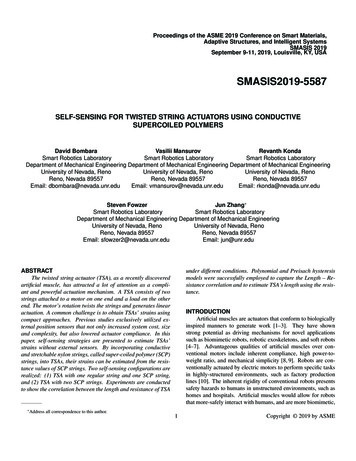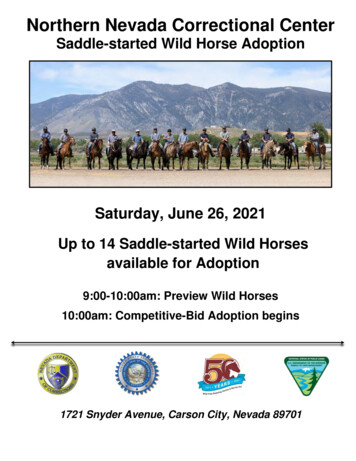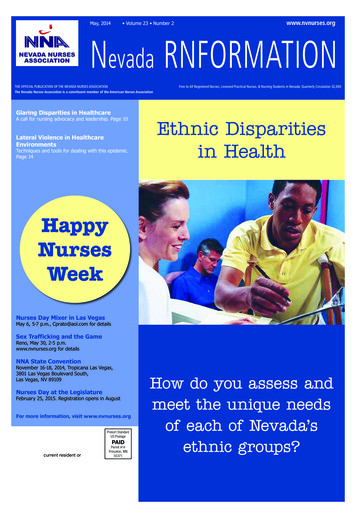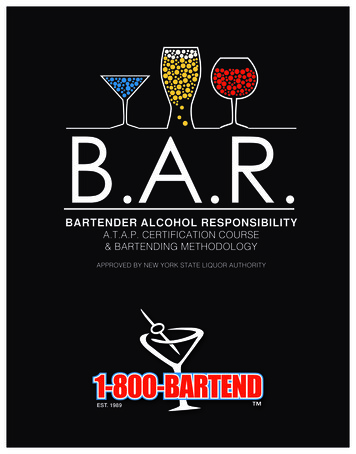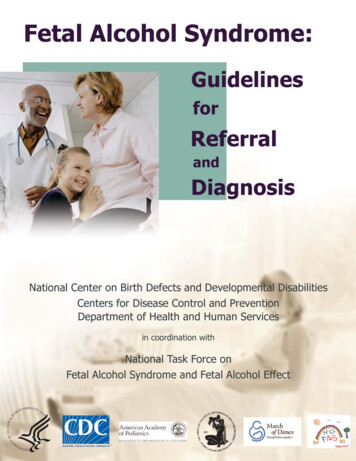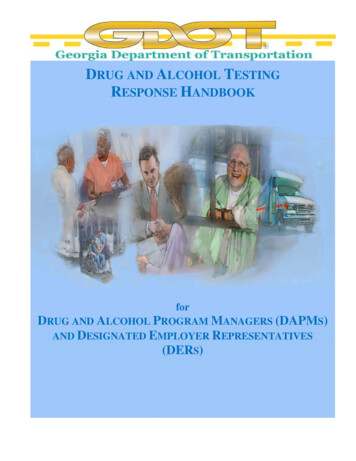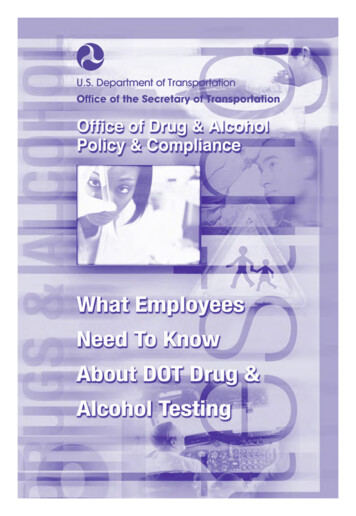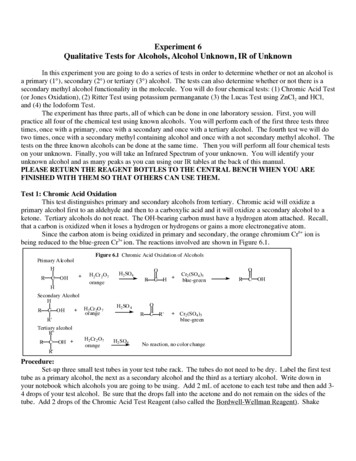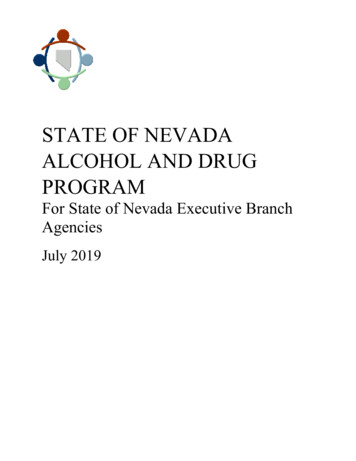
Transcription
STATE OF NEVADAALCOHOL AND DRUGPROGRAMFor State of Nevada Executive BranchAgenciesJuly 2019
TABLE OF CONTENTSI. INTRODUCTION . 5II. OVERVIEW . 6III. TESTING STANDARDS . 8ALCOHOL . 8CONTROLLED SUBSTANCES (DRUGS) . 8IV. EMPLOYEE’S RESPONSIBILITIES . 10V. SUPERVISOR’S RESPONSIBILITIES . 11VI. STATE’S CONTRACTED TESTING VENDOR . 13VII. PRE-EMPLOYMENT DRUG TESTING PROCEDURE . 14CLASSES/POSITIONS APPROVED FOR PRE-EMPLOYMENT DRUG TESTING . 14NRS 284.4066 NOTICE . 14ALCOHOL/DRUG TEST CONSENT FORM. 14CONDUCT DRUG TESTING . 15RESULTS . 15SECONDARY TESTING . 16VIII. WHAT IS REASONABLE SUSPICION? . 17ALCOHOL AND DRUG INDICATOR CHECKLIST. 17IX. REASONABLE SUSPICION ALCOHOL AND/OR DRUG TESTINGPROCEDURE . 18REPORT FORM FOR SUSPECTED ALCOHOL/DRUG IMPAIRMENT . 18PRELIMINARY INTERVIEW WITH THE EMPLOYEE. 18ALCOHOL AND DRUG TESTING CONSENT FORM . 19TRANSPORT EMPLOYEE TO COLLECTION SITE . 20CONDUCT ALCOHOL AND/OR DRUG TESTING . 21TRANSPORT THE EMPLOYEE HOME . 22RESULTS . 22Page 2
SECONDARY TESTING . 22REFER TO THE EMPLOYEE ASSISTANCE PROGRAM (EAP) . 23DISCIPLINARY ACTION . 25RETURN TO WORK. 25X. TESTING OTHER THAN PRE-EMPLOYMENT & REASONABLESUSPICION . 27DISCHARGE OF A WEAPON OR A WORK-RELATED ACCIDENT, MOTOR VEHICLECRASH OR INJURY . 27CAUSING BODILY INJURY OR PROPERTY DAMAGE DUE TO DRIVING A MOTORVEHICLE . 27XI. RELATED OFFENSES . 28DRIVING UNDER THE INFLUENCE (DUI) . 28SALE OF A CONTROLLED SUBSTANCE. 28APPENDIX I -CURRENT VENDORS . 29APPENDIX II – RELEVANT ALCOHOL & DRUG NRS & NAC .30NEVADA REVISED STATUTES . 30NEVADA ADMINISTRATIVE CODE . 35APPENDIX III - FORMS . 44CHAIN OF CUSTODY . 45REPORT FORM FOR SUSPECTED ALCOHOL/DRUG IMPAIRMENT (TS-77) . 46ALCOHOL/DRUG TEST CONSENT FORM (TS-76) . 48NON-DOT BREATH ALCOHOL TEST REQUEST (NPD-79) . 49REQUIRED REFERRAL MEMO . 50AUTHORIZATION FORM: FORMAL REFERRAL (VENDOR RELEASE OF INFORMATIONFORM) . 52APPENDIX IV – OPTIONAL TOOLS FOR SUPERVISORS . 53PRE-EMPLOYMENT DRUG TESTING FLOWCHART . 54REASONABLE SUSPICION DRUG TESTING FLOWCHART . 55REASONABLE SUSPICION GUIDE . 56Page 3
ALCOHOL AND DRUG INDICATOR CHECKLIST. 60Page 4
I. INTRODUCTIONNo organization is immune from the many problems associated with alcohol and drug abuse.According to the Society for Human Resource Management, substance abusers are ten timesmore likely to miss work, 3.6 times more likely to be involved in on-the-job accidents (five timesmore likely to injury themselves or someone else in the process), five times more likely to file aworkers’ compensation claim, thirty-three percent less productive and responsible for health carecosts that are three times as high. (Fiester, Margaret, “Employing and Managing Persons withAddictions”, SHRM Online, June 17, 2011) According to the U.S. Department of Health andHuman Services’ 2014 National Survey on Drug Use and Health, 27 million (10.2%) ofAmericans used an illicit drug in the past 30 days and 60.9 million Americans were binge orheavy alcohol users.The State of Nevada is committed to addressing these problems and to having a drug freeworkplace. As you read through the following alcohol and drug program, remember that themission of the employees of this State is to serve the needs of our citizens in the most efficientand professional manner possible. Alcohol and drug abuse interferes with these goals andendangers the employees’, co-workers’ and public’s safety. For these reasons, it must beaddressed.In addition to information and guidelines in this publication, the Division of Human ResourceManagement also provides training through the State of Nevada’s Online ProfessionalDevelopment Center.Any questions regarding this program can be referred to the Alcohol & Drug ProgramCoordinator at (775) 684-0111 or cphughes@admin.nv.gov.Page 5
II. OVERVIEWThis program does not address: U.S. Department of Transportation regulated alcohol and drug testing of employees who, as afunction of their position, drive a commercial motor vehicle as defined by the U.S. Department ofTransportation, Federal Motor Carrier Safety Administration (http://www.fmcsa.dot.gov/) ; and Client testing by agencies.The State of Nevada recognizes that alcohol and drug abuse and addiction are treatable illnesses.We also realize that early intervention and support improve the success of rehabilitation. Forthat reason, one of the goals of our program is to encourage employees to voluntarily seek helpwith alcohol and/or drug problems. If, however, a person violates the program, the consequencesare serious.The Nevada Revised Statutes (NRS), NRS 284.406 through NRS 284.407, provide for the testingof employment candidates and employees for alcohol and drugs. Regulations have beenapproved by the Personnel Commission to carry out the provisions of these statutes, NevadaAdministrative Code (NAC) 284.880 through 284.894.The State of Nevada program includes: Pre-employment drug testing for selected job classes and positions affecting public safetyand approved by the Personnel Commission, see Chapter VII; Reasonable suspicion testing when an employee is suspected of being under the influenceof alcohol and/or a controlled substance on the premises of the workplace (NAC284.0875), see Chapters VIII & IX; Testing when an employee on duty causes bodily harm or substantial property damagewhen driving a motor vehicle or is involved in a work-related accident, motor vehiclecrash or injury and when a law enforcement officer discharges a weapon; and Return to work testing as a requirement to return to work following a positive test result ona test.The program does not include periodic random alcohol or drug testing.Information obtained through this workplace program is confidential communication. Access tothis information is limited to those who have a legitimate need to know in compliance withrelevant laws and management policies.An agency receiving a federal contract or grant must notify the federal agency which authorizedthe contract or grant within ten days after receiving notice that an employee of the agency wasconvicted for violation of any federal or State criminal drug statute when such violation occurredwhile on duty or on the premises of the workplace.Page 6
Additionally, a copy of the Governor’s Alcohol and Drug-Free Workplace Policy should beposted at all worksites.Page 7
III. TESTING STANDARDSALCOHOLIn accordance with NAC 284.884, while an employee is on duty he/she must not have aconcentration of alcohol in his/her blood or breath greater than .02 gram by weight of alcohol per210 liters of breath or per 100 milliliters of blood.NAC 284.882 also mandates that testing a person’s breath for alcohol must be conducted using abreath-testing device certified in accordance with the “Conforming Products List of EvidentialBreath Alcohol Measurement Devices” published in the Federal Register by the NationalHighway Traffic Safety Administration.Breath alcohol testing is generally the preferred method of testing a person. If an agency isunable to perform a breath alcohol test, the agency may choose to have a blood alcohol testperformed.CONTROLLED SUBSTANCES (DRUGS)Per NAC 284.882, screening tests to detect the presence of “controlled substances” (drugs) mustcomply with the standards established by the United States Department of Health and HumanServices. The standards established by the United States Department of Health and HumanServices are outlined in the Mandatory Guidelines for Federal Workplace Drug TestingPrograms published by the Substance Abuse and Mental Health Services Administration in theFederal Register.Drug tests are administered to determine the presence of substances covered by this program inexcess of predetermined benchmarks. The standard substance abuse test screens for: Marijuana metabolites (THCA); Cocaine metabolite; Codeine/morphine; 6-acetylmorphine (heroin); Phencyclidine (PCP); Amphetamines/methamphetamine; and MDMA/MDA (ecstasy).Page 8
Prescription and Over-The-Counter MedicationsPrescription and over-the-counter drugs are not prohibited when taken in standard dosage and/oraccording to a physician’s prescription. Any employee taking prescribed or over-the-countermedications will be responsible for consulting the prescribing physician and/or pharmacist toascertain whether the medication may interfere with safe performance of his/her job. If the useof a medication could compromise the safety of the employee, fellow employees or the public, itis the employee’s responsibility to inform his/her supervisor as soon as possible.The illegal or unauthorized use of prescription drugs is prohibited. It is a violation of the State’sprogram to intentionally misuse and/or abuse prescription medications. Appropriate disciplinaryaction will be taken if job performance deteroriates and/or other incidents occur.Testing for Additional DrugsThe appointing authority may request additional tests for controlled substances listed onSchedule I or II of the Controlled Substances Act, when conducting a reasonable suspicion teston a case-by-case basis. However, the additional test(s) must be justified in writing at the time ofthe request. The basis for requesting additional test(s) may be noted on the Report Form forSuspected Alcohol/Drug Impairment (TS-77) form. Specific requests for additional testing maybe made at the time of testing or after the initial screening, by contacting the State’s drug testingvendor, see Chapter V. Check with the State’s current drug testing vendor immediately foradditional testing, because specimens are only kept for a certain amount of time. Check withyour agency personnel representative and your Deputy Attorney General before proceeding.Per the Mandatory Guidelines for Federal Workplace Drug Testing Programs adopted by reference inNAC 284.882, on a case-by-case basis a urine specimen may be tested for additional drugs, if the test isfor reasonable suspicion or post-accident testing.Page 9
IV. EMPLOYEE’S RESPONSIBILITIESA safe and productive alcohol and drug free workplace is achieved through cooperation andshared responsibility. Both employees and management have important roles to play.An employee’s responsibilities include: Maintaining a safe, secure and productive environment for himself or herself, otheremployees, and the general public; Reporting dangerous behaviour to his/her supervisor; Following State statutes, regulations, policies and procedures; Informing his/her agency in writing within five days after conviction for violation of anyfederal or State criminal drug statute when such violation occurred while on duty or onthe State of Nevada’s premises; Notifying his/her supervisor as soon as possible after consuming any drug, which couldinterfere with the safe and efficient performance of his/her duties; and Following a positive alcohol or drug test result: Cooperating with any investigation; Completing the treatment plan recommended by an employee assistance program(EAP) provider; and Providing the required documentation (see Chapter IX) to your agency.Page 10
V. SUPERVISOR’S RESPONSIBILITIESIt is a supervisor’s responsibility to: Maintain a safe, secure and productive environment for employees and the general public; Follow State statutes, regulations, policies and procedures; Investigate reports of dangerous practices; Safeguard employees’ confidentiality; Evaluate and discuss performance with employees; Attend training on the State's alcohol and drug program (NAC 284.498); Recognize workplace problems that may be related to use of alcohol or drugs; Initiate alcohol and/or drug testing based on reasonable suspicion or other allowablecircumstances; and Initiate appropriate disciplinary action upon violation of the State's alcohol and drugprogram.It is NOT a supervisor’s responsibility to: Diagnose alcohol and drug problems; Provide counseling or therapy; Be a police officer; or Contact an EAP or treatment provider to obtain an employee's required documentationfollowing a positive test result.A supervisor needs to keep in mind that he/she is primarily concerned with work performance orconduct. He/she also has to remember that many problems get worse without assistance. Asupervisor does not want to try to diagnose the problem, moralize or be misled by sympathyevoking tactics.A supervisor will also need to continue to supervise employees who have been tested and returnto work. This would include continuing feedback about performance, accurate performanceevaluations, keeping open lines of communication and taking corrective action if performanceproblems reappear.If a supervisor makes observations regarding the illegal distribution, possession, sale,transportation or manufacturing of controlled and dangerous substances on State property, thePage 11
supervisor needs to immediately contact his/her agency management, agency personnelrepresentative and law enforcement.Page 12
VI. STATE’S CONTRACTED TESTING VENDORAppendix I contains contact information regarding the State of Nevada’s current contractedvendor to administer drug and, at times, alcohol testing as outlined in this program.The current vendor maintains a list of authorized recipients for test results and/or billinginformation for each agency that has set up an account for testing. If any additions or changes tothe agency contacts list need to be made, the request for the change should be made in writing tothe Division of Human Resource Management, 100 N. Stewart St., Ste. 200, Carson City, NV89701, Attention: Alcohol and Drug Program Coordinator.The State’s current vendor will initially provide each agency with a supply of chain of custodyforms (see Appendix III). Agencies may replenish their supply of chain of custody forms bycontacting the State’s current vendor (see Appendix I).All positive drug test results will be sent to the Medical Review Officer (MRO). The MRO willcontact the person to offer the opportunity to explain any concerns with the test results.Example: An employee may be taking codeine for pain relief with a lawful prescription fromhis/her treating physician, meaning that the employee is not necessarily in violation of thisprogram. If the employee has a legitimate prescription for the substance, the MRO willdowngrade the presumptive positive and the agency would be notified of a negative result.However, the MRO will also verify that the level of the prescription drug in the test result iswithin the correct range indicated by the prescribed level of the drug. If the test result level isnot within the correct range indicated by the prescribed level of the drug, the result may be apositive test result. The services of the MRO are included in the testing costs.Drug test results will generally be emailed to the primary and/or the secondary contact asestablished by the agency account with the State’s current vendor. Test results may be faxedupon request; however, confidentiality must be maintained. Negative test results are typicallysent to the agency within twenty-four to forty-eight hours of the test and positive test resultswithin forty-eight hours. If you have questions or do not receive the information in a timelymanner, contact the State’s current vendor (see Appendix I).Breath alcohol testing is typically conducted through State and local law enforcement agencies;however, in some cases it may be desirable for an employee to be tested for alcohol and drugs atthe same time by the State’s current drug testing vendor. Use the Non-DOT Breath Alcohol TestRequest (NPD-79) form; see Appendix III, to have a breath alcohol test performed at a collectionsite. Before transporting the employee, verify that the collection site is capable of performing abreath alcohol test. This may involve an additional fee; whereas, breath alcohol tests conductedby law enforcement agencies are free of charge.Page 13
VII. PRE-EMPLOYMENT DRUG TESTING PROCEDURENevada Revised Statutes require post-offer/pre-employment testing of candidates for positionsdesignated by the Personnel Commission as affecting public safety. Employment is contingenton passing the screening test. Candidates already employed by the State in a position affectingpublic safety who have previously been tested and are applying for another safety sensitiveposition are not required to submit to another pre-employment drug test. (NAC 284.886)If a candidate tests positive for the use of a controlled substance, the candidate will not beeligible for another position requiring pre-employment testing for one year or until he/sheprovides evidence he/she has successfully completed a rehabilitation program for substanceabuse. (NAC 284.894)The results of the screening tests are confidential and must be securely maintained by theappointing authority or his/her designated representative. Results can be disclosed to anotherperson only as prescribed by NRS 284.4068.CLASSES/POSITIONS APPROVED FOR PRE-EMPLOYMENT DRUG TESTINGThe list of classes and positions that have received approval for pre-employment testing islocated on the Division of Human Resource Management’s website as Classes Approved for Preemployment Controlled Substance Testing. This information is also indicated on the applicableclass specification under Special Requirements. Only those candidates receiving a conditionaljob offer are required to test.If an agency wishes to propose new classes or positions to the Personnel Commission for preemployment testing, the request should be made in writing to the Division of Human ResourceManagement, Employee & Management Services’ Deputy Administrator. The request shouldinclude the classes and/or positions being proposed for pre-employment testing and anexplanation of how the position(s)/class(es) affect public safety.NRS 284.4066 NOTICEA notice covering the provisions of NRS 284.4066 must be given to applicants at or before thetime of application. The agency initiating the recruitment needs to ensure the appropriate preemployment drug testing requirement notice is on the job announcement before it is posted.Further, when making an offer of employment, the offer should clearly indicate that it isconditional upon passing the pre-employment drug test.ALCOHOL/DRUG TEST CONSENT FORMWritten consent by the candidate is required before the test is conducted. The Alcohol/Drug TestConsent (TS-76) form should be used for this purpose, see Appendix III. The original consentform is retained by the agency, a copy is given to the candidate, and a copy is included with thechain of custody form and delivered to the collection site at the time of the collection.Page 14
CONDUCT DRUG TESTINGA pre-employment drug test appointment should be scheduled at a collection site for thecandidate. The test appointment should generally be scheduled for as soon as possible. Theemployer section of the chain of custody form must be completed (Items A-D on Step 1 of theform). The candidate should be given the chain of custody form and a copy of the signedAlcohol/Drug Test Consent form (TS-76) in a sealed envelope to be delivered to the collectionsite at the time of his or her appointment. The candidate should also be provided with the date,time and location of the appointment.If a test needs to be performed outside of Nevada, contact the Drug and Alcohol ProgramCoordinator at (775) 684-0111 or cphughes@admin.nv.gov or the State’s current drug testingvendor (see Appendix I) to make arrangements for the testing to be done in the candidate’s area.A candidate will have the conditional offer of employment revoked, if he or she adulterates ordilutes the specimen, substitutes the specimen, sends an imposter, or refuses to sign the requiredforms. If the candidate is a current State employee, he or she may also be subject to disciplinaryaction.Same Consequences as a Positive Test ResultA candidate will have the conditional offer of employment revoked, if he or she: Does not appear for his/her appointment for testing, absent unusual circumstances; Refuses to test; or Refuses to cooperate in the testing process in such a way that prevents completion of thetest.If the candidate is a current State employee, the test will be considered positive for purposes ofdisciplinary action.RESULTSTest results will be emailed to the designated agency contact, typically within two working days.Test results may be faxed upon request; however, confidentiality must be maintained. If the testresults are not received within three working days, the appointing authority or the designeeauthorized for receipt of test results may contact the State’s current drug testing vendor (seeAppendix I).If a candidate tests “positive” for a controlled substance, the MRO will request proof from thecandidate to determine if it was taken pursuant to a lawful prescription. The appointing authorityshall not hire a candidate if he or she does not provide such proof within 72 hours of the request.(NRS 284.4066) The presence of marijuana will be reported as a positive test result.Page 15
An appointing authority shall, at the request of a candidate, provide him/her with the results ofhis/her screening test.SECONDARY TESTINGIf a screening test indicates the presence of a controlled substance, the MRO or the appointingauthority shall advise the candidate that he or she may have the same sample tested at his or herexpense by a laboratory, certified by the United States Department of Health and HumanServices, of his or her choice. (NRS 284.4067)Page 16
VIII. WHAT IS REASONABLE SUSPICION?In general, reasonable suspicion is specific, capable of being explained observation(s) or fact(s)concerning the appearance, behavior, speech, or body odors of the employee. Certainty is notrequired; however, mere “hunches” are not sufficient. The National Institute on Drug Abuseconsiders reasonable suspicion to include observable behavior, such as eyewitness accounts ofuse, possession, or symptoms; and abnormal conduct. Any of these factors constitutes reasonablesuspicion. In addition, the following situations automatically qualify as reasonable suspicion andprovide justification for the supervisor to require testing under NAC 284.888: Abnormal conduct or erratic behavior that is not otherwise normally explainable; The odor of alcohol or a controlled substance on the breath; Observation of the consumption of alcohol; or Observation of the possession of a controlled substance or use of a controlled substancethat is reported by a credible source.Testing may be performed in some circumstances even without reasonable suspicion, seeChapter X.ALCOHOL AND DRUG INDICATOR CHECKLISTThe Alcohol and Drug Indicator Checklist, see Appendix IV, does not provide a definite answerfor making a determination, but it does provide a list of observable symptoms and assists indocumenting the need for testing. In most cases it is suggested that a determination of reasonablesuspicion be based on more than one indicator on the checklist.Page 17
IX. REASONABLE SUSPICION ALCOHOL AND/OR DRUGPROCEDURETESTINGKeep in mind that an employee is not subject to disciplinary action for a positive screening test if theagency fails to comply with the provisions of NRS 284.4065; therefore, those provisions have beenincorporated into the steps in this program.Confronting an employee suspected of impairment can be a very uncomfortable situation. It isone that requires compliance with statutes and regulations that allow for testing and preserve therights of the employee at all steps in the process. The results of the screening tests areconfidential and must be securely maintained by the appointing authority or his designatedrepresentative. Results can be disclosed to another person only as prescribed by NRS 284.4068.Have Another Supervisor ConfirmWhenever possible, it is important to have another supervisor act as a witness to confirm yourobservations. It is recommended that the basis for the interview not be revealed to the secondsupervisor in order to avoid undue influence or bias. It is sufficient to inform a second supervisorthat there are concerns about the employee’s behavior or job performance and that he/she isbeing requested to participate in order to offer observations and an opinion.The supervisor may contact his/her agency personnel representative for assistance with theevaluation of the facts supporting the decision to refer an employee for a screening test,especially when facing such a situation for the first time. Additionally, there is assistanceavailable from the Alcohol & Drug Program Coordinator, (775) 684-0111 orcphughes@admin.nv.gov.REPORT FORM FOR SUSPECTED ALCOHOL/DRUG IMPAIRMENTIf the employee is performing, or required to perform, safety-sensitive duties such as drivingvehicles, using heavy equipment, working around explosives or weaponry, or performing patientcare activities, it is recommended that the employee be removed from performing these activitieswhile moving forward with the reasonable suspicion testing procedure.The first step after reasonable suspicion is established is to complete the Report Form forSuspected Alcohol/Drug Impairment (TS-77), see Appendix III. The Nevada Revised Statutesrequire a written record of the facts supporting a request for an employee to submit to an alcoholand/or drug test. (NRS 284.4065) Also, the employee must be informed of the specific factssupporting the request to submit to a reasonable suspicion alcohol and/or drug test. Using theReport Form for Suspected Alcohol/Drug Impairment (TS-77) will satisfy those requirements.PRELIMINARY INTERVIEW WITH THE EMPLOYEEThe supervisor should relieve the employee of his/her duties and quietly remove the employee toa private area. If at all possible, a second supervisor should be present. The employee should bequestioned regarding any observations that have been made abo
federal or tate S criminal drug statute when such violation occurred while on duty or on the State of Nevada's premises; Notifying his/her supervisor as soon as possible after consuming any drug, which could interfere with the safe and efficient performance of his/her duties; and Following a positive alcohol or drug test result:
